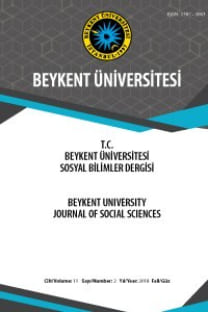Quality Improvement in Manufacturing Processes to Defective Products using Pareto Analysis and FMEA
___
- Adam, Jr., E. E. (1994). Alternative Quality Improvement Practices and Organization Performance, Journal of
- Operations Management, 12 (1): 27-44. Ahmed, M., Ahmad, N. (2011). An Application of Pareto Analysis and Cause-and-Effect Diagram (CED) for
- Minimizing Rejection of Raw Materials in Lamp Production Process, Management Science and Engineering, 5 (3): 87- Akın, B. (1996). ISO 9000 Uygulamasında İşletmelerde İstatistik Proses Kontrol Teknikleri, Istanbul:Bilim Teknik Yayınevi, 49-50.
- Akın, B., Öztürk, E. (2005). İstatistiksel Proses Kontrol Tekniklerinin Bilgisayar Ortamında Uygulanması, VII. Ulusal
- Ekonometri ve İstatistik Sempozyumu Bildirileri CD, Istanbul, 1-15. Aksay, K., Orhan, F., Kurutkan M. N. (2012). Sağlık Hizmetlerinde Bir Risk Yönetimi Tekniği Olarak FMEA:
- Laboratuvar Sürecine Yönelik Bir Uygulama, Sağlıkta Performans ve Kalite Dergisi, 121-142. Arvanitoyannis, I.S., Varzakas, T.H. (2007). Application Of Failure Mode And Effect Analysis (FMEA),
- CauseandEffect Analysis and Pareto Diagram in Conjunction with HACCP to a Potato Chips Manufacturing Plant, International Journal of Food Science and Technology, 42: 1424-1442.
- Ateş E., Oral, A., Gönen, D., İnal E. P. (2006). Ayarlanabilir Başlıklı Delme Aparatı için Tasarım FMEA Uygulaması,
- Tasarım İmalat Analiz Kongresi Bildiriler Kitabı, Eskişehir, 35-45. Baysal, M. E., Canıyılmaz, E., Eren, T. (2002). Otomotiv Yan Sanayiinde Hata Türü ve Etkileri Analizi, Teknoloji, 5(1-2), 83-90.
- Besterfield, D. H., Besterfield, C. M., Besterfield, G. H., Urdhwarashe, H., Urdhwarashe, R. (2012). Total Quality
- Management, Revised Third Edition, Pearson Publication, 297. Bircan, H., Gedik, H. (2003). Tekstil Sektöründe İstatistiksel Proses Kontrol Teknikleri Uygulaması Üzerine Bir
- Deneme, C.Ü. İktisadi. ve İdari Bilimler Dergisi, 4(2): 69-79. Bozkurt, R. (2003). Kalite İyileştirme Araç ve Yöntemleri: İstatistiksel Teknikler, Ankara: Milli Prodüktivite Merkezi Yayınları, 121.
- Canbolat, Y. B. (2000). Azerbaycan’da İlk Kalite Çemberleri Uygulaması, Journal of Qafqaz University, 3(1): 111
- Cervone, H. F. (2009). Applied Digital Library Project Management: Using Pareto Analysis to Determine Task
- Importance Rankings, OCLC Systems& Services, 25(2): 76-81. Chin, K. S.,Wang, Y. M., Poon, G. K.K , Yang, J. B. (2009). Failure Mode And Effects Analysis Using a Group
- Based Evidential Reasoning Approach, Computers & Operations Research, 36: 1768-1779.
- Cravener, T.L.,Roush, W.B., Jordan, H. (1993). Pareto Assessment of Quality Control in Poultry Processing Plants”,
- Applied Poultry Science, 2: 297-302. Çöl, Y., Eraslan, S., Gök, M., Gürlek, O., Karakoç, S., Kandiller, L., Hazır, Ö. (2008). MekaMühendislik’de Envanter
- Planlama Çalışması, [http%3A%2F%2Facademic.cankaya.edu.tr%2F~ipeks%2Fie408%2F5%2520GROUP %252 09%2520MEKA.doc&ei=qOU5ULrnNsnWtAbz6ID4Cw&usg=AFQjCNGGhmkivES4LFrhS1dbJrNWf_eECg&sig2
- =pnH2cPZ12n_PuU5Flv0-2g] (27.08.2012).
- Eleren, A. (2007). Eğitim Başarısının Artırılmasında Süreç Geliştirme Yöntemlerinin Kullanılması ve Bir Uygulama,
- Afyon Kocatepe Üniversitesi İİBF Dergisi, 9 (2): 1-25. Fedai, T., Çetin, M., Teke, A. (2010). Tedavi Sürecindeki Gereksiz Değişkenliklerin Pareto Analizi İle
- Değerlendirilmesi, Sağlık Bilimleri Dergisi (Journal of HealthSciences), 19(3): 184-190. Gitlow, H. S., Oppenheim, A. J., Oppenheim, R., Levine, D. M. (2005). Quality Management, Third Edition, McGrawHill, USA, 366-367.
- Güller, B. (2001). Odun Kompozitleri, Süleyman Demirel Üniversitesi Orman Fakültesi Dergisi, A(2): 135-160.
- Güner, M. (2009). Konfeksiyon İşletmelerinde Örgütsel Zaman Yönetimi İçin ABC Analizinin Uygulanması, Tekstil ve Konfeksiyon, 2: 163-168.
- Hoyle, D. (2000). Automotive Quality Systems Handbook, Butterworth-Heinemann Ltd. Reed Educational Publishing:
- Işığıçok, E . (2005). Toplam Kalite Yönetimine Bakış Açısıyla İstatistiksel Kalite Kontrol, Bursa: Ezgi Kitabevi: 50-71.
- Karuppusami, G.,Gandhinathan, R. (2006). Pareto Analysis of Critical Success Factors of Total Quality Management:
- A Literature Review and Analysis, The TQM Magazine, 18(4): 372-385. Kaya, İ., Ağa, A. (2004). Kalite İyileştirme Sürecinin Yedi Temel Aracı ve Motor-Traktör İmalatı Yapan Bir
- İşletmede Uygulanması”, Selçuk Üniversitesi Sosyal Bilimler Enstitüsü Dergisi, 11 [http://80.251.40.59/science. ankara.edu.tr/ozdemirt/isttatistikselkalitekontrolu/KAL%DDTE%20KONTROL/Kalite%20iyile%FEtirmede %207 %20ara%E7%20uyg.pdf] (27.08.2012).
- Kobu, B. (1987). Endüstriyel Kalite Kontrolü, Istanbul: Istanbul Üniversitesi Yayınları No:3425, 314-315.
- Kuczek, T. (2012). Failure Modes Effect Analysis, Statistical Quality Control Lecture Slides, Perdue University.
- Kumru, M., Kumru, P. Y. (2010). Hastanelerde Satın Alma Sürecinin İyileştirilmesi: Bir Örnek Uygulama, II.
- Uluslararası Sağlıkta Performans ve Kalite Kongresi Bildiriler Kitabı, 171- 183. Montgomery, D. C. (2001). Introduction to Statistical Quality Control, 4th Edition, John Wileyand Sons, 4-6.
- Russell, R. S., Taylor III, B. W. (2009). Operations Management- Along the Supply Chain, Wiley Publications, 53.
- Özcan, S. (2001).İstatistiksel Proses Kontrol Tekniklerinden Pareto Analizi ve Çimento Sanayiinde Bir Uygulama,
- C.Ü. İktisadi ve İdari Bilimler Fakültesi Dergisi, 2(2): 151-174. Özsever, Ç., Gençoğlu, T., Erginel, N. (2009). İşgücü Verimlilik Takibi İçin Sistem Tasarımı ve Karar Destek
- Modelinin Geliştirilmesi, DPÜ Fen Bilimleri Dergisi, 18: 45-58. Spackman, L. (2012). Project Management, Process Mapping, and Failure Mode and Effects Analysis, Kirtland
- Federal Credit Union. Temiz, İ., Atasoy, E., Sucu, A. (2010). Toplam Ekipman Etkinliği ve Bir Uygulama, Dokuz Eylül Üniversitesi Sosyal
- Bilimler Enstitüsü Dergisi, 12(4): 49-60. Wysk, R. A. (2010). Failure Modes Effect Analysis, LectureSlides, North Carolina State University.
- Yılmaz, B. S. (2000). Hata Türü ve Etki Analizi, Dokuz Eylül Üniversitesi Sosyal Bilimler Enstitüsü Dergisi 2 (4): 133
- Yücel, Ö. (2007). Konfeksiyon Üretiminde Hata Türü ve Etkileri Analizi , Tekstil ve Konfeksiyon, 17 (2): 126-131.
- URL-1: http://www.managers-net.com/paretoanalysis.html (05.12.2012)
- URL-2: http://www.ahsaponline.net/dergi/34/odunkompozitleri.htm (05.12.2012)
- URL-3: http://erpakademi.com/v1/index.php?option=com_content&task=view&id =298&Itemid=189 (17.12.2012)
- ISSN: 1307-5063
- Yayın Aralığı: Yılda 2 Sayı
- Başlangıç: 2007
- Yayıncı: Beykent Üniversitesi
Enigma of Silence in Organizations: What Happens To Whom and Why?
K. M. Anwarul ISLAM, M. Muzahidul ISLAM, Mahbuba ZAMAN
Empirical Analysis of Weak Form Efficiency Evidence from National Stock Exchange of India Ltd
S. AYYAPPAN, S. Nagarajan, M. SAKTHİVADİVEL, K. PRABHAKARAN
CO2 Emissions in India: Are the States Converging?
Quality Improvement in Manufacturing Processes to Defective Products using Pareto Analysis and FMEA
Analysis of Corporate Income Tax Rate Changes and Earnings Management
Martin Surya MULYADİ, Yunita ANWAR, Lili YANNY
Gender Heterogeneity in Ease of Access to Credit: The Case of a Ghanaian MFI
